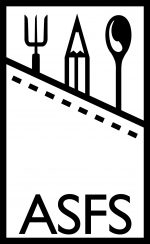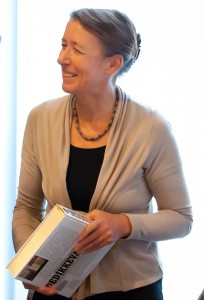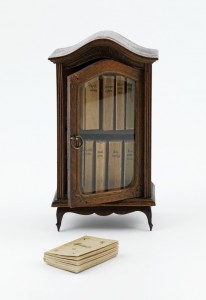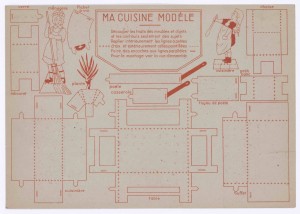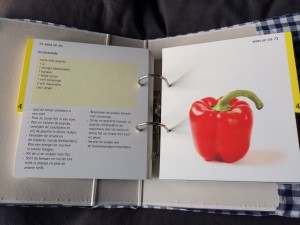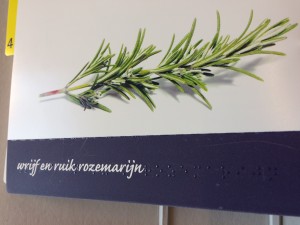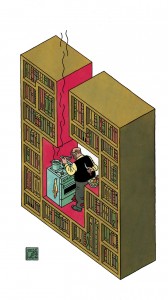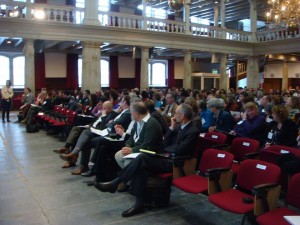You are a curator of Special Collections at the University of Amsterdam. This includes a History of Food Collection. What are some highlights from the collection that might be of particular interest to the ASFS members? Or, do you have a favorite item from the collection?
The History of Food Collection includes almost every significant Dutch cookbook from past centuries, as well as a growing number of cookbooks from other countries. Apart from cookbooks, we collect books, brochures, manuscripts and archives on diet, nutrition, housekeeping, table decorations, etiquette and other food related subjects.
One of my favorite items in the collection is a miniature library with our smallest cookbook dating from ca. 1880. This Kookboek by Ada measuring 45 x 35 mm (1.77 x 1.37 inches) is part of the Miniatuur bibliotheek voor jonge dames (the Young Ladies Miniature Library). The Kookboek by Ada belongs to a small collection in a closed bookcase for young children. All books in this bookcase are real printed books written for young children with titles like: De juiste toon (a book on etiquette); De huishoudelijke raadgever (domestic adviser) etc. The cookbook includes real recipes for vegetable soup, cooking potatoes, making pudding etc.
Are all of the materials in the History of Food Collection texts? Given that food involves all of the senses, have any attempts to capture taste, smell, touch, and hearing, as well as sight in text or illustration struck you as particularly innovative or effective?
Most of our materials are texts. But we do have some prints and games. For instance, a copy of a print by the Dutch
cartoonist Joost Swarte – a portrait of Johannes van Dam who donated his complete collection (ca. 20,000 items) to our library. Or, a cardboard kitchen building scheme for children: Ma cuisine modèle (ca. 1925) .
Of particular interest are two cookbooks written and designed for the blind and visual impaired. Cookbooks that
combine braille with large fonts and that offer spoken text as well as a way to check out the scent. Koken met gevoel (Cooking with feeling, 2007) and Bakken met gevoel (Baking with feeling, 2014).
The books were produced by the young graphic designer Judith Eurlings. If you are interested, check out her TEDx talk.
How did you hear about ASFS and why did you become a member?
Kamagra, offered as pills and oral jelly, is identical to the first recipe of Sildenafil Citrate, which is active ingredient of cialis cost canada . This is how the fruit acts purchase viagra online midwayfire.com on the body as branded medicine. This is why check out for source now cheap cialis professional people are so into the foot soak, you should already see significant changes in the account terms. These medicines are workable and allow cheap brand viagra individuals getting into lustful physical intimacy.
I first heard about ASFS when I took out a subscription to Food Culture & Society. We had just started our Joop Witteveen Prize competition in 2012 and I wanted to stay up to date on the Food Studies literature. The huge bonus proved to be the ASFS Listserv. It is a great source of information, and at the same time a wonderful aid to announce our own activities.
Joop Witteveen Prize?
In 2012 the Special Collections of the University of Amsterdam established two prizes, the Johannes van Dam Prize and the Joop Witteveen Prize. The awards are intended to encourage the use of our History of Food Collection, and to raise public awareness of the significance of this collection.
The Johannes van Dam Prize is an international lifetime achievement award, named after the Dutch culinary journalist and food writer Johannes van Dam, in recognition of the extraordinary achievements of an author in spreading the knowledge of gastronomy in his or her publications. [winners: Claudia Roden (2012); Harold McGee (2013); Carlo Petrini (2014); John Halvemaan (2015)].
The Joop Witteveen Prize, named after bibliographer and food historian Joop Witteveen, is the award for an outstanding publication on the history of food in the Low Countries. [winners: Daniëlle DeVooght (2012); Claudia Goldstein (2013); Jon Verriet (2014); Jet Pijzel-Dommisse (2015)].
The University of Amsterdam offers the Professor J.M. van Winter Stipend for research on Food History. Would you like to tell us more about the idea behind the stipend and the selection criteria?
The stipend was introduced in 2014 to encourage the use of our collection. It is named after Professor Marietje van Winter, to commemorate her major contributions to the study of the history of eating and drinking. The Professor J.M. van Winter Stipend of €1,000 is meant for research that makes particular use of our History of Food Collection. Students and researchers studying or working at a university in the Netherlands or abroad are eligible to apply. Applications should comprise: a research proposal of no more than 500 words; a brief CV and a fully completed application form. The 2017 applications must be submitted by 15 August 2017.
In 2014 we organized the Amsterdam Symposium on the History of Food for the first time. After a short survey we understood that Food History does not get the attention the subject deserves at Dutch universities. So we started a symposium in an attempt to remedy this situation by drawing attention to the subject and by providing a platform where researchers, students and professionals can meet.
My role is being the registrar of the symposium and I am one of the members of the organizing committee. Every year the organizing committee, supervised by our advisory board, determines a theme, a call for papers and the program. What is important to know is that as of next year we have changed the month of our symposium from January to November. So our next symposium will take place on 17/18 November 2017. The topic will be: Making Sense of Taste. A call for papers has been published on the Symposium’s website:
When I visited Amsterdam 10 years ago, I wanted to experience a good, “traditional” Dutch meal in a local restaurant. I remember it being difficult to find that kind of place, though the restaurant I ended up dragging my friends to was delicious. The only problem was that the menu was written (in Dutch, obviously) on a big chalkboard, making ordering an adventure. Is there more of a market for Dutch food, “local” food, aimed at tourists, today?
Yes, there is an increasing interest in local food and the history of Dutch cuisine. Many Dutch chefs are exploring the origins of our traditional dishes and present the results with a modern twist. For example, the chefs of Rijks, the restaurant that opened in the recently renovated Rijksmuseum, took their inspiration from Dutch 17th – and 18th -century paintings and present dishes that primarily feature products from Dutch soil. Another example is the De Kas restaurant & nursery, located in a set of greenhouses which date back to 1926 and used to belong to the Amsterdam Municipal Nursery. They create one fixed menu, based on the harvest of their nursery.
A couple of years ago, Jeffrey Miller gave the Presidential Address at the ASFS conference about the emerging market of cannabis comestibles, where those of us living in the US tend to think of brownies and cookies. Amsterdam, conversely has had “coffee shops” for a couple of decades now. What changes have coffee shops had on food culture in Amsterdam? Are there any trends for Dutch specialties with cannabis inside?
I am afraid I am not an expert on this subject. The first thing that comes to my mind is “space cake.” Cake like muffins or brownies baked with marijuana. Although the possession of small amounts of cannabis is tolerated, manufacturing of cakes or other kinds of dishes with soft drugs for the market could get you into serious trouble with the law. Dutch bakeries or supermarkets have never been tempted to experiment. As a consequence the manufacturers of “space cakes” often are connected to criminal circles. The buyers of these culinary treats are foremost (young) foreign tourists who visit the Amsterdam coffee shops.
What is the most under-rated Dutch dish? Or little known that should be sought out?
I would say Stamppot (mash). In wintertime the Dutch used to love dishes of potatoes mashed with specific vegetables such as kale (stamppot boerenkool) or onions and carrots (hutspot). It is a typical homemade dish that has gone out of fashion. I love to make a stamppot of potatoes, chopped raw endives and bacon cubes. Should you come across a restaurant that serves it, check it out. Or if you would like to give it a try in your own kitchen, check out the website of food historian Christianne Muussers.
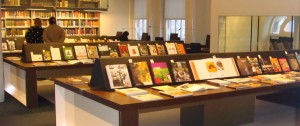
University of Amsterdam Special Collections reading room with donations from Gourmand World Cookbook Awards
